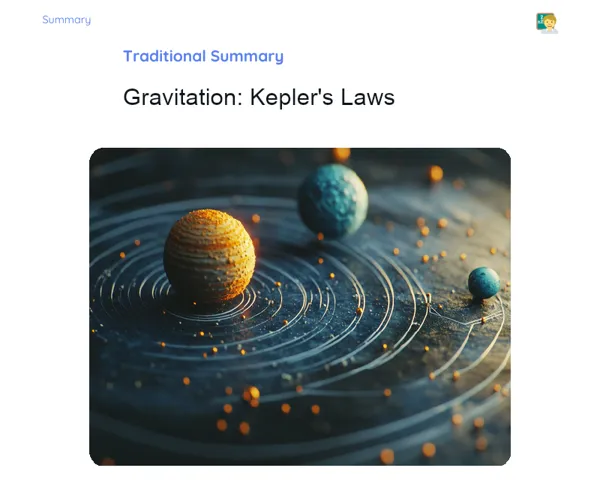Summary Tradisional | Work: Kinetic Energy
Contextualization
Kinetic energy is a key concept in physics, vital for grasping how objects move in our world. It plays a role in numerous everyday scenarios, from a car zooming down the expressway to a player kicking a ball in a cricket match. Kinetic energy is essentially the energy an object has because it's in motion, and understanding it is crucial for analyzing mechanical and dynamic systems.
To compute the kinetic energy of an object, we use the formula Ek = 1/2 * m * v², where 'm' stands for the mass of the object and 'v' is its velocity. This calculation helps us quantify the energy of a moving object, which is particularly useful for analyzing situations like vehicle accidents and the performance of athletes. Additionally, understanding the link between the change in kinetic energy and the work done on an object is a significant principle for comprehending how applied forces can change an object's motion.
To Remember!
Definition of Kinetic Energy
Kinetic energy is the energy of an object that is in motion. Essentially, if something is moving, it has kinetic energy. The quantity of this energy is determined by the mass of the object and its velocity. The heavier and faster an object is, the more kinetic energy it possesses.
Kinetic energy is one of the most significant forms of energy in mechanical systems, essential for analyzing movements and interactions between objects, like during collisions and projectile motions. A good understanding of kinetic energy allows us to predict and elucidate physical behaviours in various contexts, ranging from everyday situations to industrial and scientific applications.
Moreover, kinetic energy is a scalar quantity, meaning it has magnitude but no direction. This sets it apart from vector quantities, which include force and velocity, having both magnitude and direction. Because of this, calculations involving kinetic energy tend to be more straightforward compared to vector quantities.
-
Kinetic energy is the energy associated with a moving object.
-
It is influenced by the mass and velocity of the object.
-
Kinetic energy is a scalar quantity, having magnitude only.
Kinetic Energy Formula
The formula for kinetic energy is Ek = 1/2 * m * v². Here, 'Ek' is the kinetic energy, 'm' signifies the mass of the object, and 'v' denotes its velocity. The formula indicates that kinetic energy is directly proportional to both the object's mass and the square of its velocity.
The reason there is a factor of 1/2 in the formula is due to the mathematical derivation linking the work done on an object to its change in kinetic energy. When a force accelerates an object, the work done results in a change in kinetic energy, which is articulated in the formula.
Because velocity is squared in the formula, even minor increases in velocity lead to significant increases in kinetic energy. For example, if the speed of an object doubles, its kinetic energy increases fourfold. Understanding this aspect of the formula is crucial for analyses in situations where velocity varies considerably, such as in road accidents or sports.
-
The kinetic energy formula is Ek = 1/2 * m * v².
-
Kinetic energy is proportional to mass and the square of velocity.
-
The factor of 1/2 arises from the relationship between work and kinetic energy change.
Calculating Kinetic Energy
To calculate the kinetic energy of an object, we need to plug in the values for mass and velocity into the formula Ek = 1/2 * m * v². For instance, if we want to determine the kinetic energy of a car weighing 1000 kg moving at a speed of 20 m/s, we would substitute these values into the formula: Ek = 1/2 * 1000 * (20²), which yields 200,000 Joules.
This calculation is vital for various practical applications, such as vehicle safety engineering, where understanding the kinetic energy in collisions is essential to devise effective safety measures. In sports, determining the kinetic energy of balls and players can aid in optimizing performance and ensuring safety during competitions.
Furthermore, a solid grasp of kinetic energy calculation is necessary for tackling physics problems related to object motion, ranging from simplistic classroom challenges to advanced scientific inquiries and industrial applications.
-
Calculating kinetic energy requires substituting the mass and velocity into the formula Ek = 1/2 * m * v².
-
This calculation is crucial for practical situations such as vehicle safety and sports performance.
-
Understanding how to calculate it is foundational for solving physics problems regarding motion.
Variation of Kinetic Energy and Work
The change in kinetic energy of an object directly correlates with the work done on it. Work is defined as the change in the kinetic energy of an object, expressed in the formula W = ΔEk, where W signifies work and ΔEk is the kinetic energy change.
When a force is applied to an object, it can modify its speed, thereby altering its kinetic energy. For example, accelerating a car entails that the work performed by the engine increases the car's kinetic energy. Conversely, during braking, the work done by the brakes decreases the vehicle's kinetic energy.
Grasping this relationship is essential for analyzing scenarios involving forces, such as collisions, where the work performed by impact forces modifies the kinetic energy of the objects involved. This understanding is paramount for traffic safety and assessing impacts in various branches of engineering.
-
The change in kinetic energy is related to the work done on an object.
-
Work is defined as the change in kinetic energy (W = ΔEk).
-
Understanding this relationship is crucial for analyzing scenarios involving forces and motion.
Practical Applications of Kinetic Energy
Kinetic energy finds numerous practical applications in fields like engineering, sports, and road safety. For instance, in automotive engineering, understanding kinetic energy is critical for designing safety features, such as airbags and crumple zones, that absorb impact energy during collisions.
In sports, analyzing the kinetic energy of balls and athletes aids in enhancing performance and safety. For example, in cricket, understanding the kinetic energy of a ball hit can help decipher how various batting techniques influence the ball's speed and path.
In terms of traffic safety, the relationship between speed and kinetic energy is vital for evaluating the severity of accidents. Since kinetic energy increases with the square of speed, driving at higher speeds leads to much more severe results in case of a mishap. This understanding is vital for safety campaigns and in formulating traffic regulations.
-
Kinetic energy is applied in engineering, sports, and road safety.
-
In automotive engineering, it assists in designing safety features.
-
In sports, it aids in optimizing performance and ensuring safety.
-
In road safety, it is essential for assessing accident severity.
Key Terms
-
Kinetic Energy: The energy that an object has due to its motion.
-
Kinetic Energy Formula: Ek = 1/2 * m * v², where 'm' is the mass and 'v' is the velocity.
-
Work: The energy transferred to or from an object via the action of a force over a distance.
-
Variation of Kinetic Energy: The change in kinetic energy of an object, typically caused by the work performed on it.
-
Mass: The amount of matter contained in an object, a key factor determining kinetic energy.
-
Velocity: The rate of change of an object's position, significantly influencing kinetic energy.
-
Force: An interaction capable of changing an object's motion, can perform work and alter kinetic energy.
-
Collision: An event where two or more objects meet, leading to changes in kinetic energy and the work done.
Important Conclusions
Kinetic energy is an essential concept in physics that characterizes the energy an object has due to its motion. The formula Ek = 1/2 * m * v² enables us to compute this energy based on the object's mass and velocity, revealing that kinetic energy directly relates to both the mass and the square of the velocity. This understanding is indispensable for analyzing mechanical systems, such as vehicle collisions and sports performance.
Beyond merely calculating kinetic energy, it's crucial to comprehend the link between the change in kinetic energy and the work done on an object. The work exerted by a force can impact an object's kinetic energy, a vital consideration when analyzing practical situations like traffic safety and vehicle design. This relationship is summarised in the formula W = ΔEk, where W indicates work and ΔEk shows the change in kinetic energy.
The practical implications of kinetic energy are extensive, encompassing domains such as engineering, sports, and safety measures. In engineering, this knowledge is crucial for developing vehicle safety systems. In sports, it helps athletes and equipment perform better. In road safety, grasping kinetic energy is essential for understanding the severity of accidents and promoting safer driving habits. These instances highlight the significance of studying kinetic energy in both our daily lives and professional practices.
Study Tips
-
Familiarize yourself with the formula for kinetic energy (Ek = 1/2 * m * v²) and try calculating it with different mass and velocity values to strengthen your grasp.
-
Understand the relationship between work and kinetic energy variation (W = ΔEk) and practice solving problems that involve the application of forces and changes in kinetic energy.
-
Investigate real-world applications of kinetic energy across various fields like engineering and sports to appreciate its significance and utility.



